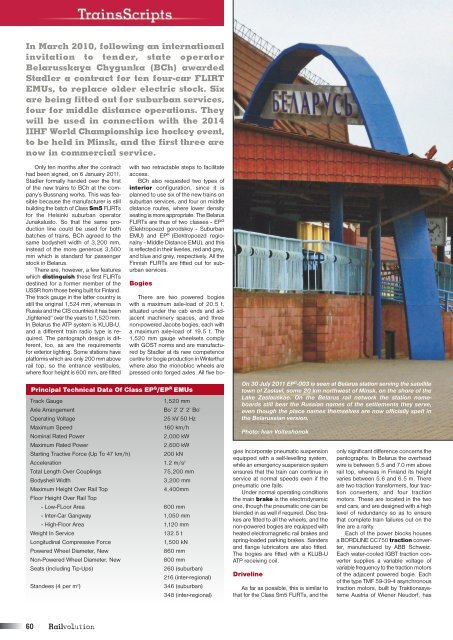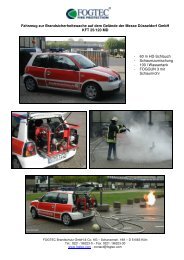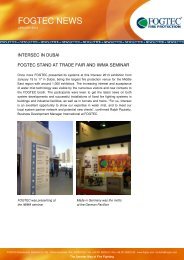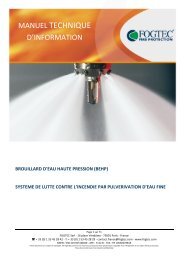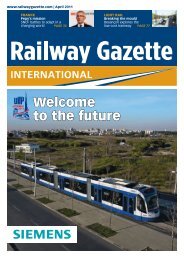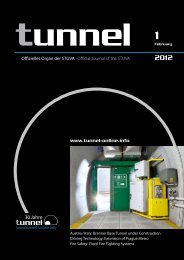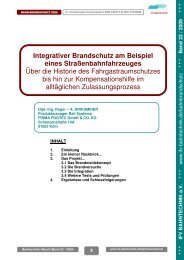You also want an ePaper? Increase the reach of your titles
YUMPU automatically turns print PDFs into web optimized ePapers that Google loves.
In March 2010, following an international<br />
invitation to tender, state operator<br />
Belarusskaya Chygunka (BCh) awarded<br />
Stadler a contract for ten four-car FLIRT<br />
<strong>EMU</strong>s, to replace older electric stock. Six<br />
are being fitted out for suburban services,<br />
four for middle distance operations. They<br />
will be used in connection with the 2014<br />
IIHF World Championship ice hockey event,<br />
to be held in Minsk, and the first three are<br />
now in commercial service.<br />
Only ten months after the contract<br />
had been signed, on 6 January 2011,<br />
Stadler formally handed over the first<br />
of the new trains to BCh at the company’s<br />
Bussnang works. This was feasible<br />
because the manufacturer is still<br />
building the batch of Class Sm5 FLIRTs<br />
for the Helsinki suburban operator<br />
Junakalusto. So that the same production<br />
line could be used for both<br />
batches of trains, BCh agreed to the<br />
same bodyshell width of 3,200 mm,<br />
instead of the more generous 3,500<br />
mm which is standard for passenger<br />
stock in Belarus.<br />
There are, however, a few features<br />
which distinguish these first FLIRTs<br />
destined for a former member of the<br />
USSR from those being built for Finland.<br />
The track gauge in the latter country is<br />
still the original 1,524 mm, whereas in<br />
Russia and the CIS countries it has been<br />
„tightened“ over the years to 1,520 mm.<br />
In Belarus the ATP system is KLUB-U,<br />
and a different train radio type is required.<br />
The pantograph design is different,<br />
too, as are the requirements<br />
for exterior lighting. Some stations have<br />
platforms which are only 200 mm above<br />
rail top, so the entrance vestibules,<br />
where floor height is 600 mm, are fitted<br />
with two retractable steps to facilitate<br />
access.<br />
BCh also requested two types of<br />
interior configuration, since it is<br />
planned to use six of the new trains on<br />
suburban services, and four on middle<br />
distance routes, where lower density<br />
seating is more appropriate. The Belarus<br />
FLIRTs are thus of two classes - EP G<br />
(Elektropoezd gorodskoy - Suburban<br />
<strong>EMU</strong>) and EP R (Elektropoezd regionalny<br />
- Middle Distance <strong>EMU</strong>), and this<br />
is reflected in their liveries, red and grey,<br />
and blue and grey, respectively. All the<br />
Finnish FLIRTs are fitted out for suburban<br />
services.<br />
Bogies<br />
Principal Technical Data Of Class EP G /EP R <strong>EMU</strong>s<br />
Track Gauge<br />
1,520 mm<br />
Axle Arrangement<br />
Bo’ 2’ 2’ 2’ Bo’<br />
Operating Voltage<br />
25 kV 50 Hz<br />
Maximum Speed<br />
160 km/h<br />
Nominal Rated Power<br />
2,000 kW<br />
Maximum Rated Power<br />
2,600 kW<br />
Starting Tractive Force (Up To 47 km/h)<br />
200 kN<br />
Acceleration 1.2 m/s 2<br />
Total Length Over Couplings<br />
75,200 mm<br />
Bodyshell Width<br />
3,200 mm<br />
Maximum Height Over Rail Top<br />
4,400mm<br />
Floor Height Over Rail Top<br />
- Low-FLoor Area 600 mm<br />
- Inter-Car Gangway 1,050 mm<br />
- High-Floor Area 1,120 mm<br />
Weight In Service<br />
132.5 t<br />
Longitudinal Compressive Force<br />
1,500 kN<br />
Powered Wheel Diameter, New<br />
860 mm<br />
Non-Powered Wheel Diameter, New<br />
800 mm<br />
Seats (Including Tip-Ups)<br />
260 (suburban)<br />
216 (inter-regional)<br />
Standees (4 per m 2 )<br />
346 (suburban)<br />
348 (inter-regional)<br />
On 30 July 2011 EP G -003 is seen at Belarus station serving the satellite<br />
town of Zaslavl, some 20 km northwest of Minsk, on the shore of the<br />
Lake Zaslauskae. On the Belarus rail network the station nameboards<br />
still bear the Russian names of the settlements they serve,<br />
even though the place names themselves are now officially spelt in<br />
the Belarussian version.<br />
Photo: Ivan Voiteshonok<br />
There are two powered bogies<br />
with a maximum axle-load of 20.5 t,<br />
situated under the cab ends and adjacent<br />
machinery spaces, and three<br />
non-powered Jacobs bogies, each with<br />
a maximum axle-load of 19.5 t. The<br />
1,520 mm gauge wheelsets comply<br />
with GOST norms and are manufactured<br />
by Stadler at its new competence<br />
centre for bogie production in Winterthur<br />
where also the monobloc wheels are<br />
pressed onto forged axles. All five bogies<br />
incorporate pneumatic suspension<br />
equipped with a self-levelling system,<br />
while an emergency suspension system<br />
ensures that the train can continue in<br />
service at normal speeds even if the<br />
pneumatic one fails.<br />
Under normal operating conditions<br />
the main brake is the electrodynamic<br />
one, though the pneumatic one can be<br />
blended in as well if required. Disc brakes<br />
are fitted to all the wheels, and the<br />
non-powered bogies are equipped with<br />
heated electromagnetic rail brakes and<br />
spring-loaded parking brakes. Sanders<br />
and flange lubricators are also fitted.<br />
The bogies are fitted with a KLUB-U<br />
ATP receiving coil.<br />
Driveline<br />
As far as possible, this is similar to<br />
that for the Class Sm5 FLIRTs, and the<br />
only significant difference concerns the<br />
pantographs. In Belarus the overhead<br />
wire is between 5.5 and 7.0 mm above<br />
rail top, whereas in Finland its height<br />
varies between 5.6 and 6.5 m. There<br />
are two traction transformers, four traction<br />
converters, and four traction<br />
motors. These are located in the two<br />
end cars, and are designed with a high<br />
level of redundancy so as to ensure<br />
that complete train failures out on the<br />
line are a rarity.<br />
Each of the power blocks houses<br />
a BORDLINE CC750 traction converter,<br />
manufactured by ABB Schweiz.<br />
Each water-cooled IGBT traction converter<br />
supplies a variable voltage of<br />
variable frequency to the traction motors<br />
of the adjacent powered bogie. Each<br />
of the type TMF 59-39-4 asynchronous<br />
traction motors, built by Traktionssysteme<br />
Austria of Wiener Neudorf, has<br />
60


